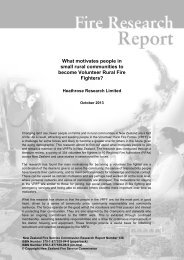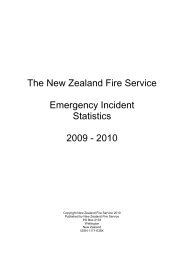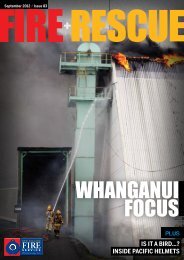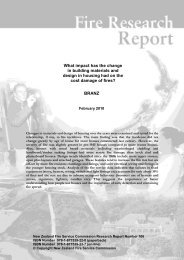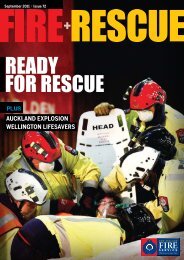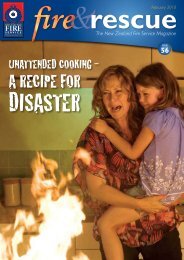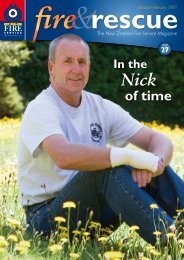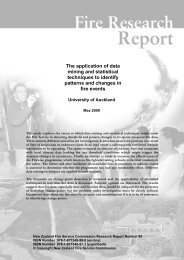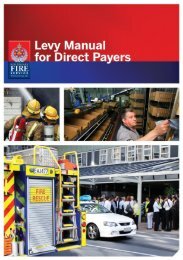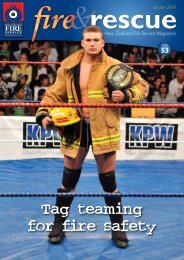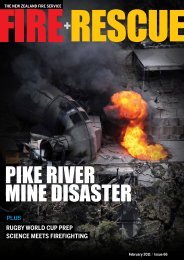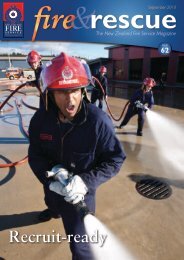Download PDF - New Zealand Fire Service
Download PDF - New Zealand Fire Service
Download PDF - New Zealand Fire Service
You also want an ePaper? Increase the reach of your titles
YUMPU automatically turns print PDFs into web optimized ePapers that Google loves.
October 2012 / Issue 84<br />
<strong>Fire</strong> in<br />
the hold<br />
Plus<br />
FIre-ambO hybrId<br />
recruIts dO the hard yards
the new zealand FIre servIce new cOmmIssIOner<br />
<strong>Fire</strong>+Rescue is the flagship<br />
publication of the <strong>New</strong> <strong>Zealand</strong><br />
<strong>Fire</strong> <strong>Service</strong>.<br />
It is produced by Media,<br />
Promotions and Communications,<br />
National Headquarters,<br />
Level 9, 80 The Terrace, Wellington.<br />
cOntrIbutIOns tO FIre+rescue<br />
We welcome ideas for articles, news<br />
and events that would be of interest to<br />
other <strong>Fire</strong> <strong>Service</strong> staff and volunteers.<br />
Draft articles and photos (pictures<br />
need to be at least 1MB) can be<br />
emailed to fire.rescue@fire.org.nz or<br />
contact the editor Karlum Lattimore<br />
on 04 496 3702.<br />
Post written material and photos,<br />
or photo CDs to:<br />
<strong>Fire</strong>+Rescue magazine,<br />
PO Box 2133, Wellington.<br />
(These will be returned on request.)<br />
www.FIre.Org.nz<br />
All material in <strong>Fire</strong>+Rescue magazine<br />
is copyrighted and may not be<br />
reproduced without the permission<br />
of the editor.<br />
ISSN: 1176-6670 (Print)<br />
ISSN: 1177-8679 (Online)<br />
FrOnt cOver<br />
Fishing boat fire fighting in Lyttelton.<br />
Photo: Fairfax Media/The Press.<br />
2 / <strong>Fire</strong>+Rescue / October 2012<br />
The <strong>Fire</strong> <strong>Service</strong> Commission<br />
has a new member, former Area<br />
Commander and current Deputy Mayor<br />
of Whanganui, Rangi Wills.<br />
nhQ Future-prOOFIng<br />
National Headquarters is getting<br />
a makeover that will make it<br />
safer in an earthquake and improve<br />
its use as the NZFS disaster response<br />
coordination centre.<br />
The <strong>Fire</strong> <strong>Service</strong> has had its headquarters in<br />
the AXA Centre on The Terrace in Wellington<br />
for the past decade. When the landlord<br />
decided to upgrade some of its services this<br />
gave NZFS the opportunity to do some<br />
future-proofing of its own as well as<br />
consider where the headquarters should be<br />
sited and what facilities were needed.<br />
After looking at other Wellington offices,<br />
the best and most cost-effective option<br />
identified was to stay in the AXA Centre<br />
and refurbish the office space. This work<br />
will begin later this year and includes<br />
setting up a properly equipped area that<br />
can be quickly transformed into an<br />
emergency National Coordination Centre.<br />
This will include technology that links the<br />
<strong>Fire</strong> <strong>Service</strong> with region Emergency<br />
Operation Centres, the hazmat/command<br />
units and other agencies such as Police,<br />
Ministry of Civil Defence and Emergency<br />
Management, and the National Crisis<br />
Management Centre in the Beehive.<br />
He replaces Bob Francis, whose term is<br />
expiring.<br />
Rangi Wills took early retirement from the<br />
<strong>Fire</strong> <strong>Service</strong> in 1995 after a 34-year career.<br />
He served in Whanganui, Wellington, Hutt<br />
Valley, <strong>New</strong> Plymouth and Gisborne and<br />
spent six years as Director of Planning and<br />
Operations for the NZFS Commission.<br />
Apart from his Council responsibilities,<br />
Mr Wills serves on many community<br />
boards and committees. He has also<br />
served on the Whanganui District Health<br />
Board and is a former member of the<br />
<strong>New</strong> <strong>Zealand</strong> Casino Control Authority.<br />
He said he was delighted and honoured<br />
with the appointment and is looking<br />
forward to taking up his role in November.<br />
“This communications technology will<br />
drive inter-agency operability and make<br />
better use of intelligence – which was one<br />
of the learnings that came out of our<br />
experience in Christchurch,” said Chief<br />
Executive Paul Baxter.<br />
“Our Christchurch experience also taught<br />
us the importance of organisational<br />
resilience. NHQ, as well as fire stations,<br />
have an important role in our overall<br />
response capability.”<br />
The upgrade will include work to improve<br />
seismic resilience and the computer<br />
servers will be moved off site.<br />
“We will also shift to the modern working<br />
environment and have fully open plan<br />
offices, including my own. Fewer walls will<br />
help communication and support our drive<br />
for a more collaborative and consistent<br />
way of working,” he said.
news<br />
from the top<br />
editorial<br />
As we head into October, the transition to the new region structure is well<br />
underway and the different parts of the organisation are getting on with<br />
putting the renewed emphasis on efficiency, effectiveness and accountability<br />
into effect.<br />
We have always set goals for our<br />
national, regional, area and station<br />
performance but we are now putting<br />
more time and attention into how<br />
we set those goals and how we measure<br />
our success in meeting them. The<br />
<strong>New</strong> <strong>Zealand</strong> <strong>Fire</strong> <strong>Service</strong> needs to<br />
know, and show, that the work we do in<br />
communities is making a difference and<br />
that we make the best possible use of<br />
public funds to do it.<br />
I acknowledge that there is a certain<br />
amount of upheaval involved with the<br />
transition. However, I am impressed that<br />
most people are doing their best to get<br />
on with their day job as well as keep up<br />
with the changes that are needed. I’ve<br />
been out meeting people in the regions<br />
and hearing a few grumbles here and<br />
there but, overall, the commitment to<br />
the job shines through. Staff are<br />
managing to find work-arounds or keep<br />
up with the old systems while we shift to<br />
the new. If you do strike something<br />
that you are unable to solve that is<br />
linked to the transition in some way,<br />
please bring it to a senior manager’s<br />
attention. It’s going to take a combined<br />
effort to make this project come to life<br />
and endure as a success.<br />
<strong>Fire</strong> <strong>Service</strong>S review<br />
The Government’s review of fire services<br />
is now underway. This review is<br />
something we have been discussing with<br />
Government for several years and we<br />
support it wholeheartedly. There is a<br />
significant disconnect between the<br />
service we provide today and what our<br />
Act empowers us to do. There are also<br />
anomalies between those who pay for<br />
our service via the <strong>Fire</strong> <strong>Service</strong> Levy and<br />
those who receive our services. It will be<br />
good to get more clarity on our functions<br />
and funding. We’ve already held some<br />
preliminary meetings with the review<br />
panel and will be making a formal<br />
submission that pulls together all our<br />
thoughts on how the organisation can be<br />
better positioned to provide fire and<br />
other emergency services to the public.<br />
Major incident<br />
analySiS<br />
At a recent AFAC (Australasian <strong>Fire</strong> and<br />
Emergency <strong>Service</strong> Authorities Council)<br />
forum we spent time talking about how<br />
much review and analysis now takes<br />
place following major emergency events<br />
and the pressure this puts on<br />
organisations. While the work to<br />
examine the response to disasters such<br />
as the Christchurch earthquake is<br />
incredibly demanding on staff, each<br />
review provides an opportunity to learn.<br />
NZFS is using the findings from its<br />
earthquake response reviews to bring in<br />
a range of changes. In particular, we are<br />
using what we’ve learned to power-up<br />
our focus on incident management.<br />
We are introducing more incident<br />
management training for executive<br />
officers and I have just contracted an<br />
Australian specialist to start work on a<br />
five-year strategy to build up our<br />
capability in this area. The broader<br />
review of the Civil Defence Emergency<br />
Management response to the<br />
Christchurch earthquake is due out<br />
shortly and we hope this too will be<br />
helpful in fine tuning our emergency<br />
response.<br />
Paul Baxter<br />
Chief Executive & National Commander<br />
<strong>Fire</strong>+Rescue / October 2012 / 3
feature<br />
All hands to<br />
the pumps<br />
Every available appliance in and around Christchurch was needed to tackle the<br />
recent fire on board a ship in Lyttelton’s dry dock.<br />
Any ship fire, poses significant<br />
hazards and tactical challenges to<br />
firefighters. This incident was no<br />
exception and the problems were<br />
compounded by leaking ammonia fumes.<br />
Late afternoon on 29 August, Lyttelton<br />
Chief <strong>Fire</strong> Officer Mark Buckley got the call<br />
to a fire on a fishing boat at the port. As he<br />
headed to the station, he could see the<br />
smoke coming up from the dry dock and<br />
immediately asked for the call to be<br />
escalated to a third alarm.<br />
“We could smell the ammonia in the air<br />
when we arrived, so set up Lyttelton’s two<br />
pumps a good 150 metres away from the<br />
ship and started boundary cooling –<br />
directing water over the hull and foredeck,”<br />
said Mark.<br />
4 / <strong>Fire</strong>+Rescue / October 2012<br />
Within minutes additional appliances and<br />
the command unit from Christchurch<br />
arrived and the executive officers linked up<br />
with Mark and the ship’s engineers to<br />
carefully plan the operation to extinguish<br />
the fire which was below deck in the bow of<br />
the boat.<br />
“We took the time to get the best<br />
information and advice from the engineers<br />
and worked out a three prong attack,” said<br />
Mark who took on the operations role.<br />
First, a crew was sent from the stern into<br />
the boat to close the watertight doors and<br />
isolate the fire. From scaffolding, around<br />
three storeys high, firefighters cut a hole in<br />
the side of the ship to give them direct<br />
access to the seat of the fire. The final<br />
move was to lift the hatch off the top of<br />
the bow to allow the fire to vent upwards.<br />
Then it was a matter of keeping the<br />
exterior cool, and dousing the flames by<br />
directing the hoses in through the hole and<br />
attacking it from the wet deck of the ship.<br />
Christchurch Senior Station Officer<br />
Dave Stackhouse took charge of the stern<br />
(rear) sector.<br />
“To close the bulkhead doors, the ship’s<br />
engineer guided our crew down three<br />
decks and through the smoke logged<br />
corridors. It was like going down a<br />
chimney. They used the delivery as a<br />
lifeline and a thermal imaging camera to<br />
keep them on track,” he said.
It was the first time the Christchurch crews<br />
used the new, long duration BA and the<br />
gear got quite a workout that night. Crews<br />
from 20 appliances were working at the site<br />
and anyone near the ship needed to wear<br />
BA to avoid the ammonia fumes. Dave said<br />
entry control was critical as there were a lot<br />
of hazards inside and outside the ship.<br />
“They have aluminium ladders, the<br />
passages are a rabbit warren and easy to<br />
get lost in and so on. But we had good<br />
procedures and managed the risk.”<br />
Assistant Area Commander Steve<br />
Kennedy took on incident command and<br />
said bringing the ship’s engineers and<br />
others who knew the ship into the<br />
operation response planning was crucially<br />
important.<br />
“They helped us navigate through the ship,<br />
explained the layout, told us where to cut<br />
the hole in the side, provided gear for us to<br />
use and so on.”<br />
Region Manager Trevor Brown said<br />
“This was a complex incident and really<br />
stretched our Christchurch resources.<br />
Every career station and several volunteer<br />
brigades were needed. It was a very well<br />
led incident and it was impressive to see<br />
the full response in action.”<br />
Trevor said there will be an operational<br />
review and he’s hoping the incident will be<br />
used as a scenario for the new Blue Card<br />
command and control training being<br />
introduced to the <strong>Fire</strong> <strong>Service</strong>.<br />
Scenes from the Ocean Breeze incident ground.<br />
PHOTOS: AARON CAMPBeLL-KOBeLL LTD<br />
feature<br />
secOnd tIme<br />
arOund<br />
For some Christchurch<br />
firefighters, the Ocean<br />
Breeze fire was a practice run for<br />
the fire on board another fishing<br />
boat a few weeks later.<br />
The Amaltal Columbia caught<br />
fire about 60 kilometres off the<br />
Canterbury coast and for Assistant<br />
Area Manager Dave Berry and<br />
Lyttelton Chief <strong>Fire</strong> Officer Mark<br />
Buckley there was an element of<br />
déjà vu.<br />
Both had worked on the Ocean<br />
Breeze fire and late in the night<br />
of 11 September they were out<br />
on a pilot boat with Area Manager<br />
Greg Crawford heading out to the<br />
Amaltal Colombia as it was being<br />
towed into port.<br />
The boat had been abandoned at<br />
sea after fire ripped through its fish<br />
meal processing deck.<br />
“We went out to meet it so we<br />
could plan our tactics for dealing<br />
with the fire once it got into<br />
Lyttelton,” said Dave.<br />
Once again, crews donned the long<br />
duration BA and tackled the fire<br />
using water deliveries and switched<br />
to foam once they came across<br />
piles of packaging cartons.<br />
“We were lucky the pumps were still<br />
operating so our firefighting water<br />
could be pumped out,” said Dave.<br />
It took the team until around 5am<br />
to bring the fire under control and<br />
another day before the hot spots<br />
were dealt to.<br />
But, like the Ocean Breeze, it was<br />
a good save. The two boats were<br />
worth about $60 million each to<br />
replace.<br />
<strong>Fire</strong>+Rescue / October 2012 / 5
FIre-ambulance<br />
Collaboration<br />
The country’s ambulance services and NZFS have always worked closely<br />
together to provide the best possible results for the patient and the public.<br />
This collaboration has become more important as clinical care becomes more<br />
technically demanding.<br />
Director of Operations and Training<br />
Paul McGill said St John is now the<br />
only provider of first aid training for<br />
the <strong>Fire</strong> <strong>Service</strong> and this relationship has<br />
given both agencies a better<br />
understanding of each other’s operations.<br />
“It also means we get the most up-to-date<br />
and informed training possible,” he said.<br />
“Last year we attended 6,000 medical call<br />
outs, which is 9 percent of our incidents.<br />
This number has almost doubled over the<br />
past decade. As a result of this growing<br />
need for our assistance, we collaborate<br />
closely with Wellington Free Ambulance<br />
and St John on our response.” This extends<br />
to looking at whether the <strong>Fire</strong> <strong>Service</strong><br />
should share its site with other emergency<br />
services, particularly ambulance stations,<br />
when building new stations. This colocation<br />
can make better use of public<br />
money and encourages a team approach<br />
to emergency responses.<br />
St John recently changed its system for<br />
prioritising its response. St John now<br />
dispatches the nearest available resource<br />
to all life-threatening and time-critical<br />
emergencies. This means <strong>Fire</strong> <strong>Service</strong><br />
brigades and career stations are more<br />
likely to be co-responded to cardiac or<br />
respiratory arrests in the future, and less<br />
likely to be dispatched to other less<br />
serious emergencies.<br />
“This makes sense as it reflects our<br />
abilities and our availability but also takes<br />
into account the need to make the best<br />
use of our volunteers’ time,” said Paul.<br />
6 / <strong>Fire</strong>+Rescue / October 2012<br />
St John Operations Director Michael<br />
Brooke said “Today the health sector faces<br />
some real challenges and to meet those<br />
challenges, St John is adapting its service<br />
delivery model so we can continue to<br />
serve our communities well. As part of<br />
this we are working with the <strong>Fire</strong> <strong>Service</strong><br />
on improving ways to work together,<br />
particularly in rural areas,” he said.<br />
<strong>Fire</strong>-ambulance vehicle<br />
As part of this, there has been mounting<br />
interest in developing a prototype <strong>Fire</strong><br />
<strong>Service</strong> vehicle that can be both a fire<br />
appliance and an ambulance.<br />
“It’s an incredibly challenging design to<br />
come up with and we are working with St<br />
John on it at the moment. The prototype<br />
will be developed using an Iveco van that<br />
arrives in the country in November,” said<br />
Paul McGill.<br />
The intent is for the prototype to be tested<br />
and trialled in a carefully managed process<br />
by brigades that have been trained to the<br />
first response standard of patient care.<br />
“Our intent is for patients to be treated in<br />
the rear compartment and, when<br />
necessary, transport them to meet an<br />
ambulance or take them to further medical<br />
or hospital care. We see this type of vehicle<br />
being used in parts of the country where<br />
there is no ambulance but where we have<br />
a brigade that is trained as a first response<br />
unit.” NZFS currently has 37 brigades that<br />
operate as first response units for medical<br />
emergencies.<br />
Vehicle Development Manager Paul Blane<br />
is heading up the design project.<br />
“The Iveco van is similar to the Iveco LRV<br />
(Light Response Vehicle). It’s big, and at<br />
about seven metres long it is about the<br />
same length as a Type I appliance and it<br />
has a seven tonne weight capacity. We are<br />
designing a body that will have a twoperson<br />
cab at the front, the pump and fire<br />
equipment storage in the middle and the<br />
rear will be a single stretcher ambulance<br />
with seating for two more crew members.<br />
The vehicle will also be fitted with a water<br />
tank,” he said.<br />
Paul and the NZFS team (John Sutherland<br />
and Chris Walbran) are working closely<br />
with St John who are designing the<br />
ambulance compartment.<br />
“Our focus is on making the pumping and<br />
firefighting equipment capability work. It is<br />
an incredibly complex design to come up<br />
with so we’ve started from scratch and are<br />
doing it step by step.”<br />
The design is likely to take several more<br />
months, with the finished vehicle expected<br />
to be on the road in the middle of next year.<br />
Above: Vehicle Development Manager Paul Blane.
Below: A mockup of what the fire-ambulance might look like.<br />
Bottom: A concept drawing of the interior showing the possible layout with<br />
the cab at the front, the pump and equipment storage compartment in the<br />
middle and the stretcher in the rea with the water tank under the floor.<br />
<strong>Fire</strong>+Rescue / October 2012 / 7
Midwinter<br />
wildfire<br />
RELATIVE HUMIDITY (%)<br />
RelAtive huMiDity AnD teMpeRAtuRe<br />
100<br />
95<br />
90<br />
85<br />
80<br />
75<br />
70<br />
65<br />
60<br />
55<br />
50<br />
45<br />
40<br />
35<br />
30<br />
25<br />
20<br />
15<br />
10<br />
5<br />
0<br />
8 / <strong>Fire</strong>+Rescue / October 2012<br />
-6<br />
06 12 18 06 12 18<br />
20 JULY 2012 21 JULY 2012<br />
OBSERVED SCREEN AIR TEMPERATURE OBSERVED SCREEN RELATIVE HUMIDITY<br />
Extremely rare, mid-winter<br />
climate and weather conditions<br />
combined for a few hours<br />
in July to create the perfect<br />
environment for a fast and<br />
furious North Otago wildfire.<br />
On Friday 20 July at around 3.30pm<br />
a farmer set fire to stubble in a<br />
paddock. He had a permit and it<br />
was a controlled burn.<br />
What no one realised was that in the few<br />
hours leading up to the farmer striking his<br />
first match, the relative humidity had<br />
plummeted. Heavy frosts had already<br />
sucked all the moisture out of the grasses<br />
and other fine fuels and a light wind was<br />
stirring. It was a recipe for disaster.<br />
36<br />
34<br />
32<br />
30<br />
28<br />
26<br />
24<br />
22<br />
20<br />
18<br />
16<br />
14<br />
12<br />
10<br />
8<br />
6<br />
4<br />
2<br />
0<br />
-2<br />
-4<br />
Within a short time the fire had blown over<br />
the paddock, jumped the fire break<br />
between the adjoining farm and was on its<br />
way. Over the next 24 hours it burned<br />
through 1,500 hectares of land, destroyed<br />
two plantations, ruined 20 kilometres of<br />
fencing and killed stock.<br />
TEMPERATURE<br />
Dunedin Principal Rural <strong>Fire</strong> Officer<br />
Graeme Still was in his woolshed at<br />
5.45pm on the Friday, when he got a call<br />
from the local rural fire officer who told<br />
him he was needed.<br />
“It was a real surprise to hear the fire had<br />
got out of control.” It made more sense<br />
when he took readings at the fire and from<br />
the local weather stations.<br />
Graeme Still<br />
“At the farm, the relative humidity was 35-<br />
36, the temperature was around 18-19<br />
degrees and the wind was blowing at about<br />
28 kilometres an hour.”<br />
A graph from nearby Middlemarch<br />
weather station showed that the relative<br />
humidity took a massive dive shortly before<br />
midday on 20 July and dropped even<br />
further overnight.<br />
“This gave us the same sort of fire<br />
conditions you would expect on a hot<br />
summer day,” he said.<br />
Six helicopters were involved with the<br />
incident, and 40 personnel, plus 4 x 4<br />
smoke chasers and slip-on units. The<br />
wildfire was contained by 4.00pm on<br />
Saturday 21 July.<br />
PHOTO: OTAgO DAILy TIMeS<br />
National Rural <strong>Fire</strong> Officer Murray Dudfield<br />
said NRFA’s partnership with NIWA on new<br />
fire weather prediction software will help<br />
avoid this type of situation. He says the<br />
computer system draws on information<br />
from around 200 weather stations. The<br />
results will provide rural fire managers with<br />
modelling that will forecast localised weather<br />
conditions, potential daily fire behaviour, fuel<br />
moisture conditions and potential fire<br />
spread rates with much more accuracy.<br />
The new system will be trialled this summer<br />
before being officially rolled out.
ecruIt traInIng<br />
what it really feels like<br />
Attending any training course can by a bit daunting, but<br />
when it involves your first exposure to smoke, flames and<br />
working in the dark, it’s downright alarming.<br />
Recently, four volunteer recruits from the Paraparaumu<br />
Brigade completed their basic training at the National<br />
Training Centre.<br />
Nadine Hodge, Amelia Rae, Jo Ganc and Isaiah Smith<br />
kept a brief diary of their experiences which will be used<br />
by NZFS to give other recruits an idea of what it’s like.<br />
From left:<br />
Isaiah, 18, is an apprentice mechanic<br />
and became interested after watching the<br />
brigade practise hose drills one night.<br />
amelia, 20, is an electrician and has workmates<br />
who are firefighters.<br />
nadine, 36, is an early years educator and<br />
has wanted to be firefighter since she was eight<br />
years old.<br />
Jo, 40, is a Corrections officer and joined after<br />
meeting the wives of two local brigade members<br />
at a netball game. “I said I had always wanted to<br />
do that so I was told to turn up to training on<br />
Monday night!”<br />
<strong>Fire</strong>+Rescue / October 2012 / 9
new recruIts<br />
“an awesome week”<br />
Here’s some of what<br />
they experienced.<br />
Friday<br />
Nadine: Arrived in Rotorua. Hotel is nice.<br />
Briefing with senior trainer after dinner<br />
and met the rest of the recruits – 11<br />
altogether (six men, five ladies). Reminded<br />
about knowing our knots, so went to our<br />
rooms to practise our knot tying.<br />
Amelia: Worried about sleeping through<br />
my alarm and wondering what the future<br />
week had in store. A very nervous night<br />
having no idea about what to expect.<br />
Jo: Arrived a bit excited and unsure of<br />
what I have got myself into! Met some of<br />
the others and they are really nice. Met for<br />
a briefing and still feeling unsure. Early<br />
night to be bright and early in the morning.<br />
Saturday<br />
Jo: Arrived at the training centre and was<br />
given a tour of the awesome facility. We<br />
spend the second half of the day doing<br />
hose drills. I felt good with that as we had<br />
done lots of practice of the hose drills and<br />
waterway equipment.<br />
Amelia: Was such a relief as the day<br />
progressed to find out the instructors were<br />
really nice, good and thorough and patient.<br />
First time having a ‘uniform inspection’.<br />
Was glad I got my ironing right.<br />
Nadine: Start of the day involved a parade<br />
and how we are to present ourselves each<br />
day followed by an hour in the classroom.<br />
Isaiah: I fell over today when running out a<br />
hose and hurt my knee. Our trainers are<br />
really great.<br />
10 / <strong>Fire</strong>+Rescue / October 2012<br />
Sunday<br />
Jo: Was good to have more hose drills and<br />
then they brought out the ladders. OMG!<br />
I was a bit nervous as I had a fear of heights,<br />
then to be told that we had to wear a<br />
harness was even more scary cos that<br />
means a possibility of falling. But I bit the<br />
bullet and went first to get it over with. Third<br />
time up was without the harness, so even<br />
though I wanted to be sick, I did it three<br />
times and am no longer scared of that!<br />
Isaiah: I strained a muscle and re-hurt<br />
my knee on a ladder today. I’m afraid that<br />
if I hurt myself too much I might not be<br />
able to finish the training. I’ve been fighting<br />
a cold and have lost my voice much to the<br />
delight of the girls from my station who<br />
think I talk too much.<br />
monday<br />
Nadine: Vegetation was the topic for<br />
today. Morning started with theory in class<br />
followed by making up forestry hoses into<br />
pineapples and packing up a forestry kit.<br />
Identification of tools and how they are<br />
used correctly on the fire ground. We took<br />
a drive over to the airport where we were<br />
put into two crews to create a firebreak.<br />
Blood, sweat and tears digging, raking and<br />
creating a trench for a hose.<br />
Jo: Bad weather meant it wouldn’t be as<br />
much fun as it could be. Had a test that<br />
was not as scary as I first thought it would<br />
be. The rural fire trainers were very good<br />
and it was a great day. Hard work tho<br />
making the fire break. That was a killer!<br />
tueSday<br />
Amelia: Into the BATB (Breathing<br />
Apparatus Training Building) today was<br />
like a challenging obstacle course. Wearing<br />
the BA cylinder made things difficult but it<br />
was good. It reinforced everything our<br />
tutors had been telling us about the<br />
importance of working as a team and how<br />
you need to communicate. If you don’t you<br />
end up in there for longer.<br />
Nadine: BA theory in class. Test, don,<br />
start, re-commissioning repeated several<br />
times. Shown inside the BATB with the<br />
lights on and shown what we are to endure<br />
wearing our BA set. Techniques/<br />
manoeuvres are demonstrated by one of<br />
the trainers through it. Only way I can<br />
describe it is a mini army assault course<br />
condensed into an average size lounge<br />
area filled top to bottom with obstacles!<br />
Jo: This was the most uncomfortable thing<br />
I have done in my life. Small spaces, heat,<br />
darkness and trusting in other people that<br />
they know what they are doing by letting<br />
us go through this. Small consolation was<br />
that no one had died in there. I did not like<br />
it and a small mishap in there sent me out<br />
at speed, thinking that I do not want to do<br />
this! After talking to the trainer about what<br />
had gone wrong, went for afternoon tea,<br />
only to come back and find out that we had<br />
to go back in! This time it was with<br />
partners, so I was lucky to have someone<br />
that I trusted and knew that he was<br />
confident in the task. So YAY me got<br />
through ALIVE thanks to Matt!<br />
WedneSday<br />
Nadine: Our first exercise today was going<br />
through the BATB in crews carrying a<br />
70mm coiled hose using each other to<br />
complete the course carrying it through.<br />
The remainder of the day featured search<br />
and rescue. We were taken over to a house<br />
and shown how to search thoroughly<br />
around rooms using your hands and hose.<br />
After lunch we carried out several search<br />
and rescues on the upper level of the BATB<br />
which is set out like an apartment. We<br />
learnt how to use the hose on door entry
and how to enter. The trainers were<br />
observing how we searched and<br />
communicated between crews. Techniques<br />
were practised on removal of patients<br />
which was sometimes a challenge.<br />
Amelia: Today was a bit harder than<br />
yesterday. My shoulders were already sore<br />
from the previous day so putting the BA set<br />
onto sore shoulders wasn’t fun but straight<br />
back into it and forgot about the weight of<br />
the cylinder. It is really different not being<br />
able to see due to the dark room and makes<br />
searching techniques become vital.<br />
Isaiah: This was a really hard day and after<br />
coming through the BATB there were<br />
some tears from some people and I almost<br />
cried but as a guy not wanting to show my<br />
feelings I stuck my head in a bucket of<br />
water to cool myself off and get a grip.<br />
thurSday<br />
Nadine: This morning we sat in class for a<br />
BA theory test. After morning tea we<br />
travelled to Rotorua <strong>Fire</strong> Station where<br />
they have the RFTB (Realistic <strong>Fire</strong> Training<br />
Building). Again no time is wasted and BA<br />
sets are ready to don and we are shown<br />
around. Then the fire was lit and the<br />
building started to heat up. We all donned<br />
our BA and entered as a group to watch<br />
the intensity of the fire and how quickly the<br />
room filled with smoke. We practise<br />
staying low and comparing the visibility<br />
and heat levels.<br />
Amelia: Today we went into the RFTB and<br />
it was awesome! Absolutely enjoyed it.<br />
Was great to experience real fire and what<br />
its actually going to be like in a real house<br />
fire. It really proved how well our gear<br />
works which was reassuring for the future.<br />
Jo: I was in a crew with Amelia who found<br />
a ‘patient’ and we decided that I would get<br />
the patient downstairs. We descend down<br />
the stairs, Amelia guiding me down. At the<br />
bottom of the stairs we get separated and<br />
so head towards where I know the door is,<br />
then got stopped and told that we have to<br />
follow the hose out (makes sense!).<br />
Dragging the patient around the bottom<br />
floor is very hard work, the legs got stuck<br />
round the corner and I am pulling this<br />
heavy thing trying to get it out! Then my<br />
crew is stuck behind me and we can’t<br />
move. By this time I am exhausted from<br />
dragging this patient in the heat and just<br />
want to get it out. We get to the door and<br />
my warning whistle goes off and PASS<br />
alarm. Another crew member takes the<br />
patient out and I am assisted out by my<br />
crew and trainer. Was a little bit dramatic<br />
but now I look back and laugh. Was just the<br />
heat and physical exhaustion from<br />
dragging the patient, I was fine really, after<br />
I got all my gear off. Actually I think it was<br />
my favourite day when I look back, maybe<br />
not at the time though.<br />
Isaiah: This was my favourite day of the<br />
entire course and also the first time most<br />
of us had experienced real live fire. It was<br />
the hardest though. At the end of it my legs<br />
felt like jelly and I was asleep as soon as<br />
my head hit the pillow.<br />
Friday<br />
Amelia: Best water fight ever! It was a<br />
blast literally. We were having smoko, next<br />
minute sirens going and into the truck for<br />
a drill. It was exciting and fun and then a<br />
water fight trainees vs instructors. We got<br />
them soaked! It was a good end to the<br />
week. It was one of the most mentally and<br />
physically challenging things I have done<br />
but it was absolutely great. Thoroughly<br />
enjoyed it and can’t wait to go back.<br />
Training facilities were top notch and<br />
instructors too!<br />
Nadine: Morning session in the classroom<br />
on extinguishers, Drills in the yard<br />
extinguishing pot and oven fires and<br />
flammable liquids. We were all assigned to<br />
a truck and connected a water supply for a<br />
hose drill. Not long after applying the water<br />
we were soon having water applied to us<br />
by the trainers who stood on top of the<br />
trucks using the ground monitors,<br />
completely drenching us. We retaliated<br />
and got them wet too. It was the biggest<br />
water fight I had ever had.<br />
After drying off we went to the classroom<br />
to sign off paperwork and give feedback on<br />
the course. We then went to the drill yard<br />
for our passing out parade and<br />
presentation of our blue stripes. On that<br />
final fall-out command, the feeling of relief,<br />
exhaustion, pride and self-achievement<br />
was quite overwhelming and brought tears<br />
to my eyes.<br />
It was one of the most challenging but<br />
fulfilling weeks of my life!<br />
Jo: Well, made it to day 7. The past week<br />
has been an awesome week for me, I have<br />
learned that I can still achieve my goal.<br />
even at 40!<br />
Isaiah: All through training that morning I<br />
was sad I would leaving at lunchtime. But it<br />
was with great pride that I received my<br />
blue squares that meant I was now a<br />
firefighter, no longer a recruit. I left with<br />
mixed feelings.<br />
To sum up the course as a whole, I would<br />
have to say it was the most fun week of my<br />
life. But at the same time the most<br />
challenging. In all honesty I do not think I<br />
would have made it, had I not been part of<br />
such an awesome team, and had the best<br />
instructors in the world. So thank you<br />
everyone so, so much!<br />
<strong>Fire</strong>+Rescue / October 2012 / 11
Changes in regions<br />
Regions now have staff dedicated to NZFS fleet requirements, property maintenance, and planning<br />
and performance. The changes have been made to allow Area Managers and Volunteer Support<br />
Officers to better focus on their core roles.<br />
Top: National Property Manager Kevin Stacey.<br />
Above: Manager Injury, Illness and<br />
Rehabilitation Alison Barnes.<br />
12 / <strong>Fire</strong>+Rescue / October 2012<br />
ProPerty<br />
National Property Manager Kevin Stacey<br />
said the obvious change to the way the<br />
organisation manages its property is that<br />
all buildings will now be managed as a<br />
national asset and all Property staff will<br />
report to NHQ .<br />
Up until now, most people responsible for<br />
fire stations and other buildings have not<br />
had specific qualifications and there has<br />
been no real consistency about funding<br />
or scheduling of repairs or maintenance.<br />
Each Region now has a dedicated Property<br />
Coordinator who is responsible for<br />
maintenance of stations and other buildings.<br />
“As we move to the new structure,<br />
all NZFS property is being surveyed and<br />
a maintenance schedule planned and<br />
programmed in. This survey will be<br />
finished by the middle of next year.<br />
We are also moving toward employing<br />
pre-approved contractors. This means,<br />
for example, that instead of getting<br />
someone in to do one small painting job,<br />
we will tender out the many painting jobs<br />
that we know are coming up,” he said.<br />
The Property staff will also be programming<br />
in regular, routine maintenance, such as<br />
servicing appliance doors. This will be done<br />
systematically, rather than ad hoc or only<br />
doing something when the doors don’t<br />
open properly. This planning and<br />
programming will result in fewer urgent,<br />
and often costly, repairs.<br />
“We have a lot of deferred maintenance<br />
and it’s likely to take a couple of years to<br />
catch up. But our intention is that all our<br />
property will be well maintained and fit for<br />
purpose,” said Kevin.<br />
SaFety and wellbeing<br />
Like the property function, the<br />
organisation’s safety and wellbeing<br />
strategy, standards, information and<br />
tools will be developed centrally at NHQ.<br />
The team of five Region Safety and<br />
Wellbeing Coordinators will also be<br />
managed centrally.<br />
Manager Injury, Illness and Rehabilitation<br />
Alison Barnes said “<strong>New</strong> tools and<br />
supporting information will be developed<br />
over time. Meanwhile, the upgraded<br />
Accident and Event Reporting and<br />
Investigation Kiosk on <strong>Fire</strong>net is already<br />
proving to be much easier to use than the<br />
old system. We want everyone to use the<br />
Accident Kiosk to report any accident or<br />
near miss. This will help us monitor trends<br />
as well as make sure people are getting the<br />
help and support they need,” she said.<br />
Fleet<br />
The Region Fleet Coordinators also work<br />
out of the Region <strong>Service</strong> Centres and<br />
report to the National Fleet Manager. They<br />
will be working closely with region staff to<br />
make sure they get what they need in the<br />
way of red or white fleet vehicles.<br />
The fleet budget (which covers the<br />
whole country) has been finalised and the<br />
team is now working on drafting their<br />
business plan and transitioning to the<br />
new region structure.
IntrOducIng…<br />
the data miners<br />
Want to know if your project with Plunket is driving down the fire<br />
risk? Or has your station recycling project saved money as well as<br />
helped the environment? The new Planning and Performance staff<br />
in regions can help you find out.<br />
Setting goals and measuring progress<br />
against those goals is not new to the<br />
<strong>Fire</strong> <strong>Service</strong>. But there is now a<br />
greater emphasis on building up business<br />
planning skills and capability to drive<br />
efficiency and effectiveness.<br />
As a result of the Region Restructure and<br />
Realignment Project, NZFS now has<br />
dedicated a Planning and Performance<br />
team in each region. They are the Planning<br />
and Performance Manager, a Planning and<br />
Intelligence Officer and a Business Analyst.<br />
They will work with the other Region staff<br />
to drive business planning at a region, area<br />
and station level.<br />
This includes helping staff develop task<br />
force plans, emergency response plans and<br />
community risk reduction plans. They also<br />
have a role in managing regions’ response<br />
data and intelligence-gathering using our<br />
own, and other agencies’, information.<br />
Realignment Project steering committee<br />
chairman Ian Pickard said “These people<br />
have a talent for mining data and pulling<br />
together information on which to base<br />
forward planning. As an organisation,<br />
we collect a wealth of data through SMS<br />
and other systems. The Planning and<br />
Performance teams will squeeze out every<br />
ounce of useful information and use it to<br />
drive new initiatives and improvements in<br />
our operational efficiency and effectiveness.<br />
They will also develop and use national<br />
templates and processes to make sure<br />
that all regions are working consistently<br />
and share the benefits of their new insights<br />
and better ways of working,” said Ian.<br />
“As a Region Manager, I believe the<br />
introduction of these new roles in the<br />
regions will make a huge difference to the<br />
way we work. With their input, we will be<br />
able to better target our efforts to reduce<br />
the fire risk in our communities. We will<br />
also be better prepared to respond to<br />
major emergencies.”<br />
Region 2 Planning and Performance<br />
Manager Donna Stemmer says<br />
performance management has a bit<br />
of a bad rap. “In reality it should be seen<br />
as a way to give clarity to vague concepts.<br />
Top: The new Planning and Performance Managers.<br />
From left: Region 3 Lliam Munro, Region 2 Donna<br />
Stemmer, Region 5 Neil Finn-House, Region 1<br />
Paul Turner.<br />
Above: Ian Pickard<br />
We use planning and performance<br />
measurement to create an environment<br />
for success. For me, success is both<br />
efficiency (doing things right) and<br />
effectiveness (doing the right things).<br />
We balance capability, availability and<br />
dependability with cost. Our PPM team’s<br />
role is to help translate, focus and align the<br />
day-to-day actions that will help deliver on<br />
the organisation’s vision – working with<br />
communities to protect what they value.<br />
<strong>Fire</strong>+Rescue / October 2012 / 13
success FOr<br />
marae fire safety<br />
A recent visit by staff to a<br />
Kawhia marae led to some<br />
significant changes.<br />
Kawhia Chief <strong>Fire</strong> Officer Callan Stewart<br />
began the initiative by taking information<br />
on the NZFS Marae <strong>Fire</strong> Safety programme<br />
to members of the Rakaunui marae<br />
committee. He got a great reception.<br />
The committee and Callan arranged for<br />
Ma - ori Liaison Officer Lana Ngawhika and<br />
Senior <strong>Fire</strong> Risk Management Officer Kevin<br />
Holmes from Hamilton to visit Rakaunui to<br />
provide the committee and marae trustees<br />
with a Marae <strong>Fire</strong> Safety report.<br />
Kevin and Lana made a number of<br />
recommendations and a short time later<br />
the trustees told them they had got stuck<br />
in and made changes. They put up fire<br />
action notices throughout the marae and<br />
restricted the number of people who could<br />
sleep in certain areas. They had also<br />
arranged for annual checks of their<br />
firefighting equipment, and begun storing<br />
their mattresses in a separate room away<br />
from the carved wharenui (meeting house).<br />
The trustees also took up the Kawhia<br />
Brigade’s offer to install smoke alarms in<br />
all rooms used for sleeping, where there<br />
was not already smoke detection.<br />
The report also suggested ways the marae<br />
firefighting water supplies could be<br />
improved and the brigade has helped to<br />
install a <strong>Fire</strong> <strong>Service</strong>-compatible coupling<br />
to their bore.<br />
“The marae is also developing evacuation<br />
schemes for each building,” said Lana.<br />
14 / <strong>Fire</strong>+Rescue / October 2012<br />
Callan is full of praise for the marae<br />
representatives. “While the installation of<br />
permanent fire detection systems may still<br />
be some time away, their interim steps are<br />
highly commendable. They have most<br />
definitely provided a higher level of<br />
protection for the marae and their people.”<br />
Even better news is that Rakaunui Marae is<br />
not alone.<br />
Ngatira Marae in Litchfield (South Waikato)<br />
was visited by Lana as part of the Marae<br />
<strong>Fire</strong> Safety programme back in June 2007.<br />
“There was very little in the way of fire<br />
detection or protection at that time, except<br />
for several large fire extinguishers”.<br />
She and <strong>Fire</strong> Risk Management Officer<br />
Stu Cradock re-visited Ngatira again<br />
recently and found some exciting changes<br />
– including the installation of a full Type 7<br />
fire alarm system.<br />
InvestIture<br />
Left: Rakaunui marae.<br />
Above: CFO Callan Stewart and firefighter<br />
Robyn Vincent at the marae.<br />
“The marae trustees have completely<br />
embraced the concepts of fire safety,”<br />
said Stu. There was very little they could<br />
add from the latest visit to update the<br />
Marae <strong>Fire</strong> Safety report.<br />
The marae now has a comprehensive<br />
emergency management plan with action<br />
notices displayed throughout all of its<br />
buildings.<br />
Lana was delighted. “It’s proof that our<br />
Marae <strong>Fire</strong> Safety programme is making<br />
a real difference – and helping our Ma - ori<br />
communities to protect what they value.”<br />
There are around, 1,100 marae throughout<br />
the country. To arrange a fire safety survey<br />
for a marae in your patch contact your<br />
Regional Ma - ori Liaison Officer or <strong>Fire</strong> Risk<br />
Management Officer.<br />
The hard work and dedication of six volunteer firefighters was recently recognised<br />
when they were presented with the Queen’s <strong>Service</strong> Medal by the Governor-General,<br />
Sir Jerry Mataparae. From left: Woodville Chief <strong>Fire</strong> Officer Eric Bonny; former<br />
Okaihau Chief <strong>Fire</strong> Officer Colin Thomas; Wellsford Chief <strong>Fire</strong> Officer Jim Bowmar;<br />
retired Ashburton firefighter Allan McQuarters; Waiouru firefighter and former Officer<br />
in Charge of Hutt Valley <strong>Fire</strong> Police Unit Major David Ackroyd; and Coromandel Chief<br />
<strong>Fire</strong> Officer John Walker.
evacuatIOn<br />
practIce<br />
makes perFect<br />
Staff at the Kaikohe ABC Childcare Centre<br />
put their fire drill into practice when<br />
mattresses in their ‘nap’ area caught fire.<br />
<strong>Fire</strong> Risk Management Officer Lindsay<br />
Murray said the six-monthly trial<br />
evacuations really paid off.<br />
“One of the adults saw the mattresses on<br />
fire, set off the alarm and everyone went<br />
out to the assembly point.”<br />
He said it was a ferocious fire and the<br />
assembly point, which was inside the<br />
school fence, quickly became unsafe so<br />
staff lifted the children over to get them<br />
clear. The gate in the fence was locked and<br />
the key was inside the burning school.<br />
The fire investigation was done by <strong>Fire</strong> Risk<br />
Management Officer Craig Bain who said it<br />
was caused by a faulty light fitting.<br />
Craig said there was one slight hiccup in<br />
the evacuation. “The teacher was used to<br />
carrying out the trial evacuation, where<br />
they went to an office to get a key to set off<br />
the alarm, and rather than smash the glass<br />
panel, this is what they did.”<br />
Below: The ABC fire marked the end of Lindsay<br />
Murray’s career. He retired last month after 12 years<br />
with the <strong>Fire</strong> <strong>Service</strong>. He is the Chief <strong>Fire</strong> Officer of<br />
Kaeo Brigade and continues in that role. He’s been a<br />
member of the brigade for 47 years.<br />
Above: Lindsay Murray<br />
a couple of minutes with<br />
RON_Devlin<br />
Q:<br />
A:<br />
Q:<br />
A:<br />
Q:<br />
A:<br />
Where are you stationed?<br />
Region 2 HQ Tauranga<br />
What’s your title?<br />
<strong>Fire</strong> Region Manager Region 2<br />
What’s been your progression<br />
within the NZFS?<br />
Joined in 1978 and served<br />
mostly around Wellington Central<br />
for about 20 years. During this time<br />
I moved through the ranks to CFO.<br />
Did a short stint as CFO of Taupo in<br />
1998 before moving into the CFO<br />
Tauranga role in the same year,<br />
eventually being appointed as Area<br />
Manager in 2009.<br />
Q: Family?<br />
A:<br />
I have three daughters, Miranda,<br />
Chloe, Chelsea and my partner<br />
Deborah has a son Cameron.<br />
Q:<br />
What’s the one thing<br />
that sticks in your mind<br />
about the job?<br />
We are a useful organisation<br />
A: that does meaningful and<br />
positive things for people. I have<br />
always liked that.<br />
Q:<br />
If you could make one<br />
change to the <strong>Fire</strong> <strong>Service</strong><br />
what would it be?<br />
I think it would be really good<br />
A: if our legislation supported and<br />
reflected the true value the <strong>Service</strong><br />
adds to the public.<br />
Q:<br />
A:<br />
Q:<br />
Your most embarrassing<br />
moment on the job?<br />
Far too many to recount in this<br />
minute.<br />
What’s one thing people<br />
would be surprised to learn<br />
about you?<br />
I have a 11.2 metre sailing boat<br />
called the Union Jack, that I race.<br />
A:<br />
Favourite book?<br />
Mad Bad and Dangerous to Know,<br />
by Ranulph Fiennes<br />
Favourite movie?<br />
Guy Ritchie’s – Snatch<br />
Favourite TV show?<br />
Not a big TV fan, but I do enjoy<br />
cooking shows and Grand Designs<br />
Favourite music group?<br />
Pink Floyd, Rolling Stones,<br />
classic rock<br />
Favourite sport<br />
I enjoy playing golf<br />
Favourite holiday destination?<br />
Looking forward to Vietnam<br />
next year<br />
If I wasn’t in the <strong>Fire</strong> <strong>Service</strong> I’d be?<br />
I really enjoy cooking, maybe<br />
I would own a restaurant<br />
<strong>Fire</strong>+Rescue / October 2012 / 15
FIreFIghters On the pIste<br />
Weighed down with hose and structural firefighting suits, 22 firefighters raced up<br />
and down Coronet Peak in the 2012 Chill Factor Challenge.<br />
The teams of four were tasked with making as many ascents and descents as they<br />
could on the slopes within a two-hour period. Their efforts raised more than<br />
$8,400 for Queenstown charity the Bruce Grant Youth Trust.<br />
Wanaka firefighter Caleb Hansen completed the fastest individual climb in 3min<br />
22sec, while the Queenstown skiing team made 11 ascents and descents with a<br />
hose and took first place in the team event.<br />
This was the second year the event has been held, organised by Auckland Airport<br />
firefighter Tony Scott. He intends it to be an annual event, held in the third week of<br />
August, and hopes it will become the southern equivalent of the Sky Tower challenge.<br />
“We had five more teams competing this year and have managed to raise over four<br />
times what we raised last year. It is fantastic to see how much this event has grown.”<br />
Tony said although the fire hose race was tricky, the firefighters had improved on<br />
last year.<br />
Below: Some of the Chill Factor competitors.<br />
1-3 November<br />
National 7 A-Side Soccer Tournament<br />
Napier<br />
Contact: tony.adie@fire.org.nz<br />
2-3 November<br />
Thames Volunteer <strong>Fire</strong> Brigade<br />
125 year celebrations<br />
Thames<br />
Contact: Siobhan Flanigan<br />
at siobhan.flanigan@fire.org.nz or<br />
Shane Bromley 027 279 1071<br />
9-10 November<br />
National Snapper Fishing Tournament<br />
Coromandel<br />
Contact: dave.gunn@fire.org.nz or<br />
027 232 1071<br />
For the latest information on <strong>Fire</strong> <strong>Service</strong> sports events go to:<br />
<strong>Fire</strong>net/Sports/upcomingsportsevents<br />
14 November<br />
NZFS National Mountain Bike<br />
Championships<br />
Nelson<br />
14 November registration<br />
15 November championship<br />
16 November guided riding<br />
Contact: nelsonfsmtbclub@gmail.com<br />
25 November<br />
National NZFS Triathlon<br />
Championships<br />
Napier<br />
Contact: Brendon Lodge<br />
hbmsc@xtra.co.nz<br />
tOugh guys<br />
Three Auckland firefighters have been taking out<br />
the top titles in the Tough Guy and Gal Challenges<br />
held around the country for the last few years.<br />
The challenges involve a 12 kilometre run through<br />
mud, obstacles and other difficulties.<br />
Mangare’s Jacson Klutz, Otara station’s Josh<br />
Harrison and Dan Van Hoppe from Papatoetoe<br />
station are keen, competitive athletes who take on<br />
(and regularly win) a range of different sporting<br />
challenges, including the Sky Tower Challenge.<br />
Most recently, they battled the Army, Navy, Air Force<br />
and Police for the <strong>Service</strong>s Trophy which they have<br />
now taken home for the fourth year in a row.<br />
Jacson said “For this event, all the services put in a<br />
team of three and their collective times and placings<br />
are scored to find the ultimate services team. The<br />
competition is extremely tough and competitive.“<br />
In that race, Jacson was placed second in the<br />
individual men’s open, Josh was third and Dan 12th.<br />
Above: Jacson Klutz tackles the muddy water at Linton<br />
army camp.<br />
4 December<br />
Auckland <strong>Fire</strong> <strong>Service</strong> Golf Club<br />
JAFFA Open<br />
Waitakere Golf Club<br />
Entries close 16 November<br />
Contact: hayden.robinson@fire.org.nz<br />
or 021 893 861<br />
lyndon.bodger@fire.org.nz<br />
10-12 May 2013<br />
Feilding Volunteer <strong>Fire</strong> Brigade<br />
125th Jubilee<br />
Contact: John Bongenaar<br />
Feilding Volunteer <strong>Fire</strong> Brigade<br />
PO Box 444, Feilding<br />
Ph 06 323 3942 or 021 701 110<br />
feildingfire125jubilee@gmail.com<br />
CReDIT: MARATHON-PHOTOS.COM



